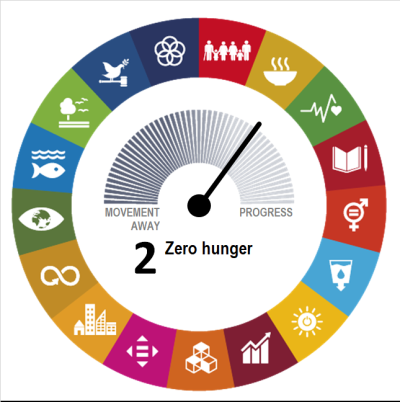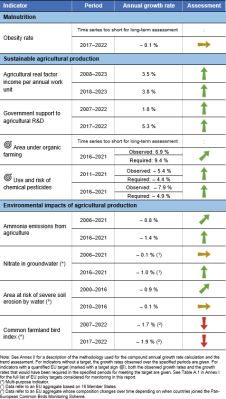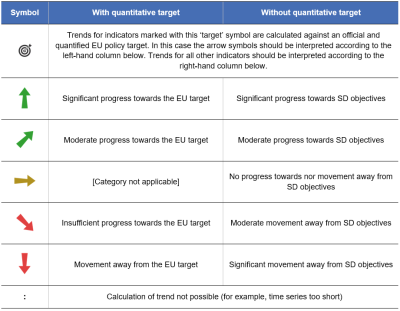SDG 2 - Zero hunger
End hunger, achieve food security and improved nutrition and promote sustainable agriculture
Data extracted in April 2024.
Planned article update: June 2025.
Highlights
This article is a part of a set of statistical articles, which are based on the Eurostat publication ’Sustainable development in the European Union — Monitoring report on progress towards the SDGs in an EU context — 2024 edition’. This report is the eighth edition of Eurostat’s series of monitoring reports on sustainable development, which provide a quantitative assessment of progress of the EU towards the SDGs in an EU context.
SDG 2 seeks to end hunger and malnutrition, and ensure access to safe, nutritious and sufficient food. Realising this goal will largely depend on promoting sustainable production systems and increasing investment in rural infrastructure and agricultural research and development.
Full article
Zero hunger in the EU: overview and key trends
Achieving healthy diets and ensuring agricultural systems remain productive and sustainable are essential for achieving a healthy food system that is good for people and the planet. Monitoring SDG 2 in an EU context includes tracking developments in obesity, the sustainability of agricultural production and the environmental impacts of agricultural activities on land, water and the atmosphere. Over the past five years, progress towards SDG 2 has been modest. There have been strong improvements in sustainable agricultural production practices monitored in this report, including labour productivity, public investments in farming, and reducing the use and risk of pesticides. The area under organic farming has also grown in the EU, but stronger progress will be required to meet the respective target by 2030. The prevalence of obesity, while stable over the five-year period assessed, remains a serious public health problem. Progress on reducing some environmental impacts has been mixed, showing both positive and negative trends. Intensive agriculture remains a major driver of biodiversity decline in the EU.
Malnutrition
A healthy diet means an adequate, well-balanced diet that meets the body’s dietary needs. Combined with regular physical activity and the avoidance of excessive alcohol consumption and tobacco use, a healthy diet is a cornerstone of good health. While ending hunger and all forms of malnutrition are key objectives of the 2030 Agenda, in Europe obesity is a more serious nutrition-related health issue.
More than half of the EU population is overweight and every seventh person is obese
Obesity and pre-obesity are malnutrition problems related to changing consumption and activity habits and contexts that favour such unhealthy habits. Combining a balanced nutritional diet with an adequately active lifestyle is a challenge for many people. While the causes of obesity vary from person to person, the problem is generally attributed to unhealthy diets that are high in energy, fat, trans fat and saturated fat, salt and sugar, and low in fruit and vegetables, whole grains, legumes and nuts, and too high in red and processed meat. Low physical activity and sociological and hereditary factors are also important causes. The contexts, such as the food environment, in which lifestyle choices are made, are important determinants of health behaviours and obesity.
Obesity is a significant health issue in the EU, affecting almost 15 % of the adult population in 2022. It is also a contributing factor in other diet-related non-communicable diseases, such as cancer, cardiovascular diseases and diabetes. Obesity also disproportionately affects people with lower levels of education and generally tends to increase with age until late in life [1]. Childhood obesity also remains an important public health problem in Europe, despite childhood obesity rates levelling off in some European countries [2].
When considered together with pre-obesity, the situation looks even more severe, with more than half of the adult EU population being overweight in 2022. Patterns in the pre-obesity rate follow patterns in the obesity rate, though pre-obesity affected more than twice as many Europeans as obesity (36.5 % of the adult population) in 2022.
Between 2017 and 2022, the share of overweight (obese and pre-obese) people fell slightly, from 51.8 % to 51.3 %. This is largely due to a reduction in the share of pre-obese people, from 36.9 % in 2017 to 36.5 % in 2022, while the share of obese people remained stable at just below 15 %, affecting 14.8 % of EU adults in 2022.
At the Member State level, the obesity rate rose in 19 countries between 2017 and 2022. The rate was highest in Malta, with 26.1 % in 2022, and lowest in Italy and Romania, with 7.1 % and 10.3 %, respectively.
The obesity rate generally increases with age, peaking in the age group 65 to 74 years (19.7 % obese in 2022) and decreasing again for people aged 75 and older. Obesity and pre-obesity rates also appear to decrease with higher educational levels, with obesity rates ranging from 10.5 % in 2022 for adults with tertiary education to 17.9 % for adults with lower secondary education or lower. The obesity rate was also lower among younger people aged 16 to 24, with 4.5 % [3].
Sustainable agricultural production
Sustainable agricultural production is a key element in making food systems fair, healthy and environmentally friendly. A concerted effort is needed to foster a food-production system that is based on sustainable agricultural practices and produces an adequate supply of food. Four indicators are used to monitor the strong interlinkages that agricultural production has with the social, economic and environmental dimensions of sustainability. These are: agricultural income and labour productivity, investment in agricultural research and innovation, organic farming and pesticide use.
Labour productivity in EU agriculture has increased, as has investment in the future of farming
To ensure its long-term viability, Europe’s agricultural sector needs to achieve economic sustainability. Labour productivity is an important component of this and can be partially measured using the indicator ‘agricultural real factor income per annual work unit (AWU)’.
Following a dip during the economic crisis in the late 2000s, agricultural real factor income per AWU has been rising in the EU. By 2023 it was 34.2 % higher than it had been in 2015. This is mainly due to strong growth between 2016 and 2017 and again between 2020 and 2022, driven partly by increased output values (prices and/or yields) and partly by a reduced labour input [4]. After two years of above-average growth, the indicator in 2023 had slipped back to 6.6 % below its 2022 peak.
Agricultural real factor income per AWU varies considerably between Member States and farm types. It tends to be higher in countries with more mechanised, input-intensive production systems than in countries using more traditional, labour-intensive methods [5].
Investment in agricultural research and innovation is crucial for decoupling agricultural productivity from environmental impacts. Such investments also help to keep EU farmers competitive and adaptable to challenges such as climate change and feeding a rising population. Overall in the EU, national government support to agricultural research and development has risen in the short term, growing by 29.8 % since 2017 to reach EUR 3.6 billion in 2022.
Organic farming is on the rise across the EU, but the pace needs to quicken to reach the 2030 target
Organic farming is one example of a sustainable agricultural management system. It seeks to limit environmental impacts by using agricultural practices that encourage responsible use of energy and natural resources, maintain or enhance biodiversity, preserve regional ecological balances, increase soil fertility and water quality, encourage high animal welfare standards, and enhance the capacity to adapt to climate change.
In the EU, the share of organic farming in total agricultural area grew by 2.8 percentage points between 2016 and 2021, to an estimated 9.9 %. Despite this, the take-up of organic farming will need to accelerate significantly to achieve the 25 % target by 2030. Across the EU, Austria leads with more than 25 % (2020 data) of its agricultural area farmed organically, followed by Estonia and Sweden with levels slightly above 20 %, and Portugal, Italy, Czechia and Latvia, each with levels between 15 % and 20 % (2021 data). In all other Member States, organic farming was practised on less than 15 % of agricultural land in 2021.
The EU is on track to meet its reduction target for the use and risk of chemical pesticides and the sales of antimicrobials for animals
The Farm to Fork Strategy also aims to reduce the EU food system’s dependency on pesticides and antimicrobials, which will contribute to its biodiversity and zero pollution objectives. According to a trend analysis by the European Commission, the use and risk of chemical pesticides decreased by 33 % between the baseline period of 2015–2017 and 2021 and the use of more hazardous pesticides fell by 21 % over the same time span. Over both the long- and short-term periods assessed in this report (2011 to 2021 and 2016 to 2021, respectively), the use and risk of chemical pesticides fell more strongly than required to meet the 50 % reduction target, meaning the EU is currently on track to meet this target by 2030. Nevertheless, the presence of pesticides in soil and water continues to be a concern. In its 2023 briefing on the issue, the European Environment Agency concluded that despite progress on reducing pesticide use, pesticide pollution remains a significant risk to human health and the environment. To protect human and animal health, the Farm to Fork Strategy also aims to reduce EU sales of antimicrobials for farmed animals and aquaculture by 50 % by 2030. The use and misuse of antimicrobials in agriculture contributes to the problem of microbes such as bacteria and fungi becoming resistant to antimicrobials, which reduces the effectiveness of such treatments. As of 2022, the EU has achieved a 28.3 % reduction in EU sales of antimicrobials for farmed animals and in aquaculture compared with the 2018 baseline [6].
Environmental impacts of agricultural production
Agriculture provides environmental benefits such as maintaining specific farmland ecosystems and diverse landscapes, and providing carbon sinks. However, increases in agricultural productivity and a move towards intensive agriculture practices have contributed to the degradation of environmental conditions and climate change. The environmental impacts of agriculture include nutrient-related pollution, soil erosion and loss of biodiversity.
Excessive nutrient inputs are threatening the environment and water quality
Ammonia emissions and nitrates in groundwater are linked to excessive inputs of nitrogen from agricultural sources such as mineral fertiliser and livestock manure. Manure from livestock is rich in nutrients such as nitrogen (ammonia and nitrates) and phosphorus, and is used as a fertiliser alongside chemical fertilisers. If properly treated, its application improves soil structure and enhances soil organic matter content, which increases carbon sequestration. But when mineral fertilisers or manure are not properly handled and spread, excess nutrients that are not taken up by plants are released into the environment (as ammonia in air and as nitrates and phosphorus in water). When released into the atmosphere, ammonia pollutes the air and can land on soil and water, where it can harm sensitive vegetation systems, biodiversity and water quality through eutrophication and acidification.
Since the 1990s, Europe has seen a significant decrease in ammonia emissions from agriculture due to reductions in livestock density and nitrogen fertiliser use as well as changes in agricultural practices. In recent years, however, developments have been less clear, with ammonia emissions increasing between 2013 and 2017, before falling to a new low of 3.0 million tonnes by 2021. It must be noted that the national and EU totals may mask considerable variations in fertiliser application and livestock densities at regional and local levels. Overall, however, ammonia emissions from agriculture remain the main nutrient pollutant of concern regarding negative effects on biodiversity [7].
The concentration of nitrate (NO3) in EU groundwater has shown a long-term stagnation at around 21 milligrams per litre (mg/L). However, there has been a recent downward trend since 2016, with concentrations reaching 20.5 mg/L in 2021. This is 1.3 % lower than in 2006 and 5.1 % lower than the 2016 peak. Nevertheless, hot spots exist where nitrate concentrations are above 50 mg/L, which is the limit set for drinkable water. Several of the countries struggling the most with high nitrate levels in groundwater are also among those with the highest ammonia emissions per hectare of utilised agricultural area in Europe, such as Malta, Belgium and Germany.
The agricultural sector is also responsible for significant quantities of greenhouse gas (GHG) emissions [8], accounting for almost 11 % of total GHG emissions in the EU in 2022. Agricultural emissions are generally linked to the management of agricultural soils, livestock, rice production and biomass burning. While the EU’s total GHG emissions have decreased by 12.3 % since 2017 (see the article on SDG 13 ‘Climate action’), emissions from the agricultural sector have fallen much slower, by 5.3 % over the same period. By 2022 they had reached 366 million tonnes of CO2 equivalent, which is 24.3 % lower than the 1990 level of 483 million tonnes [9].
Soil erosion remains a major threat, but signs of improvement exist across the EU
Healthy soils are essential for sustainable and productive agricultural systems. Because soils take years to form, they can be considered a non-renewable resource for food production. One of the biggest threats to soil health in Europe is soil erosion, which can be caused by both wind and water. Though erosion is a natural process, inappropriate land management and other human activities can cause it to accelerate to such an extent that soil can be irreversibly lost. The area at risk of severe soil erosion by water (leading to the loss of more than 10 tonnes of soil per hectare per year) is a model-based indicator based on spatial data of rainfall erosivity, soil erodibility, topography, land cover and management practices.
In the EU, 196 853 square kilometres (km2) of land was at risk of severe soil loss from water erosion in 2016 — an area equal to about 1.5 times Greece’s total land area. The risk of severe soil erosion has been decreasing in the EU, in part due to mandatory cross-compliance measures in the EU Common Agricultural Policy (CAP). The share of non-artificial erodible area [10] estimated to be at risk of severe soil erosion by water decreased from 6.1 % to 5.3 % between 2000 and 2016.
Higher agricultural productivity can lead to biodiversity losses
Some agricultural landscapes provide valuable and unique habitats for a host of species, both common and threatened. However, biodiversity has suffered under growing pressure from the race to increase productivity and where ecosystem services, which are provided by features that support biodiversity, have not been given economic value or adequate regulatory protection. Species related to agroecosystems are likely to have fared worse without the agri-environmental measures contained in EU policies — primarily the Common Agriculture Policy — but measures have not yet been effective enough to halt overall biodiversity loss in agricultural habitats [11].
Farmland bird species depend on agricultural habitats. Because they are relatively visible, they are a good indicator species for monitoring biodiversity. The common farmland bird index measures the relative abundance and diversity of 39 farmland bird species compared with the 2000 base year. Between 2007 and 2022, the EU saw dramatic declines of 23.1 % for common farmland birds, continuing a trend visible since 1990. Between 1990 and 2022, common farmland birds declined by 39.9 %. Intensive agricultural practices and the use of pesticides have contributed to the loss of wildlife habitats as well as falling populations of insects. Insects are an important food source for many farmland birds and provide important ecosystem services such as pollination.
Main indicators
Obesity rate
This indicator is derived from the body mass index (BMI), which is defined as the weight in kilograms divided by the square of the height in metres. People aged 18 years or over are considered obese if their BMI is equal to or greater than 30. The category ‘pre-obese’ refers to people with a BMI between 25 and less than 30. The category ‘overweight’ (BMI equal or greater than 25) combines the two categories pre-obese and obese. The data presented in this section stem from the European Health Interview Survey (EHIS) and the EU Statistics on Income and Living Conditions (EU-SILC).

Source: Eurostat (sdg_02_10)
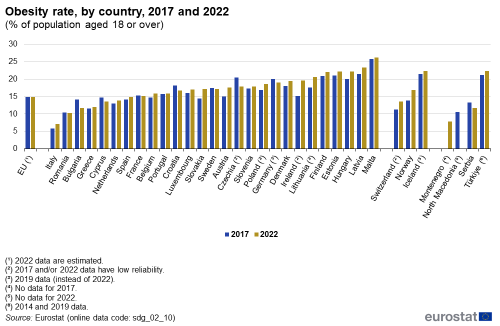
Source: Eurostat (sdg_02_10)
Agricultural real factor income per annual work unit
Agricultural real factor income measures the income generated by farming, which is used to remunerate borrowed or rented factors of production (capital, wages and land rents) as well as own production factors (own labour, capital and land). Annual work units (AWUs) are defined as full-time equivalent employment (corresponding to the number of full-time equivalent jobs), which is calculated by dividing total hours worked by the average annual number of hours worked in full-time jobs within the economic territory. This can be interpreted as a measure of labour productivity in agriculture. The data stem from the Economic Accounts for Agriculture (EAA), which provide detailed information on agricultural sector income.
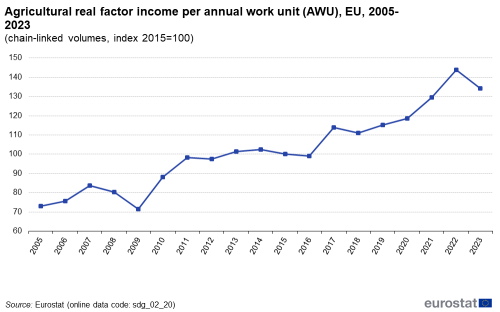
Note: y-axis does not start at 0.
Source: Eurostat (sdg_02_20)
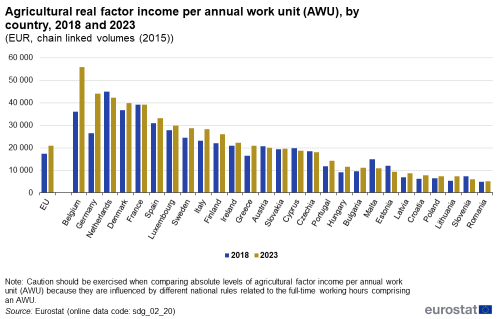
Source: Eurostat (sdg_02_20)
Government support to agricultural R&D
This indicator refers to government budget allocations for R&D (GBARD). GBARD data measure government support to research and development (R&D) activities or, in other words, the level of priority that governments place on the public funding of R&D. GBARD data are built up using the guidelines laid out in the standard practice for surveys of research and experimental development, the OECD ’s Frascati Manual from 2015 and the European Business Statistics Methodological Manual for R&D statistics of 2023.
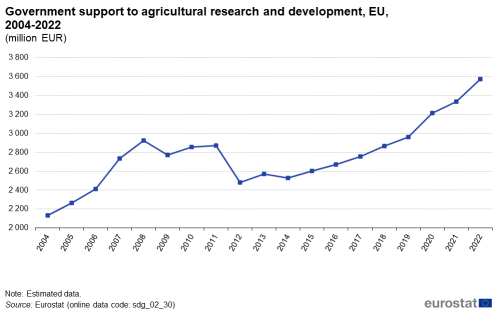
Note: y-axis does not start at 0.
Source: Eurostat (sdg_02_30)
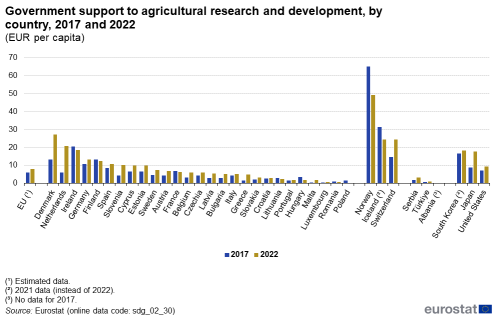
Source: Eurostat (sdg_02_30)
Area under organic farming
This indicator is defined as the share of total utilised agricultural area (UAA) occupied by organic farming (existing organically farmed areas and areas undergoing conversion). Organic farming is a production method that puts the highest emphasis on environmental and wildlife protection and, with regard to livestock production, on animal welfare considerations. It avoids or largely reduces the use of synthetic chemical inputs such as fertilisers, pesticides, additives and medical products.

Source: Eurostat (sdg_02_40)
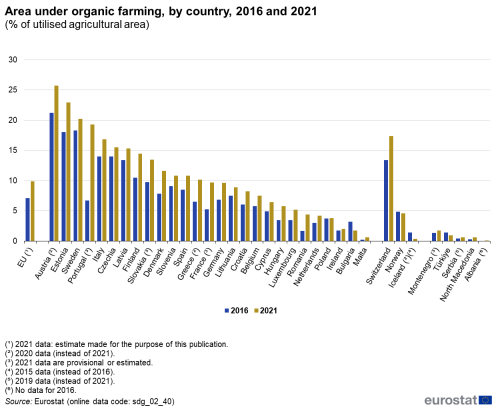
Source: Eurostat (sdg_02_40)
Use and risk of chemical pesticides
The indicator monitors the trends in the use and risk of chemical pesticides in the EU and its Member States. The use of pesticides entails risks and impacts on human health and the environment. The indicator is based on the quantities of chemical active substances contained in the pesticides which are placed on the market (sold), and therefore used, in each Member State, and the hazard properties of these active substances. The data are presented as an index relative to the average results for the period 2015 to 2017.
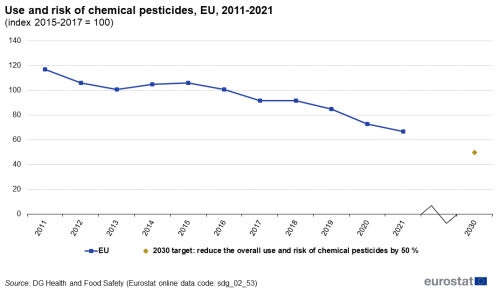
Source: Eurostat (sdg_02_53)
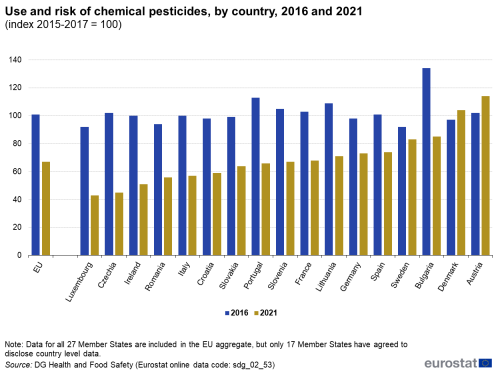
Source: Eurostat (sdg_02_53)
Ammonia emissions from agriculture
The indicator measures the amount of ammonia (NH3) emissions as a result of agricultural production. These emissions result from manure management, applications of inorganic nitrogen fertilisers and animal manure applied to soil, as well as urine and dung deposited by grazing animals. Data for this indicator come from the EU inventory on air pollution compiled by the European Environment Agency (EEA) under the Convention on Long-range Transboundary Air Pollution (LRTAP) and are fully consistent with national air pollution inventories compiled by EU Member States. Data on the utilised agricultural area (UAA) stem from Eurostat’s annual crop statistics. The definition of this indicator is based on the CAP indicator C45 Emissions from agriculture.
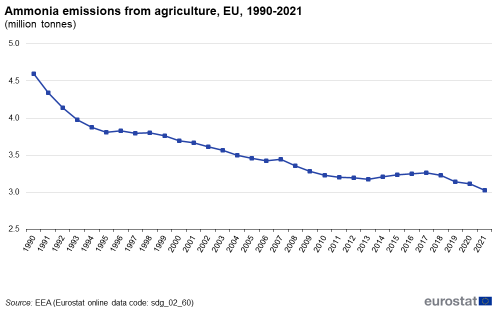
Note: y-axis does not start at 0.
Source: Eurostat (sdg_02_60)
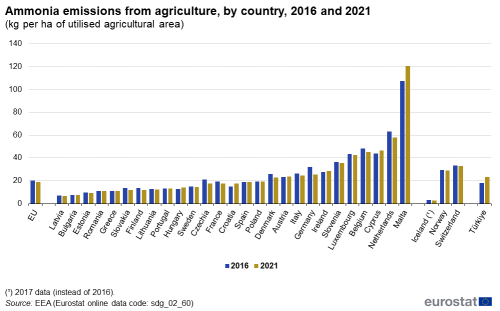
Source: Eurostat (sdg_02_60)
Direct access to
More detailed information on EU SDG indicators for monitoring of progress towards the UN Sustainable Development Goals (SDGs), such as indicator relevance, definitions, methodological notes, background and potential linkages can be found in the introduction as well as in Annex II of the publication ’Sustainable development in the European Union — Monitoring report on progress towards the SDGs in an EU context — 2024 edition’.
Further reading on zero hunger
- European Commission (2023), First 'zero pollution' monitoring and outlook –'Pathways towards cleaner air, water and soil for Europe', Brussels.
- European Environment Agency (2024), State of Europe's environment.
- FAO, IFAD, UNICEF, WFP and WHO. 2023. The State of Food Security and Nutrition in the World 2023: Urbanization, agrifood systems transformation and healthy diets across the rural–urban continuum. Rome, FAO.
- FAO and IWMI (2018), More people, more food, worse water? A global review of water pollution from agriculture, FAO Publishing, Rome.
- OECD (2019) The Heavy Burden of Obesity, The Economics of Prevention
- FAO and UNEP. 2021. Global Assessment of Soil Pollution: Report. Rome.
Further data sources on zero hunger
- EEA, Food consumption — animal based protein.
- European Commission, Trends in Harmonised Risk Indicators for the European Union.
- Eurostat, Economic accounts for agriculture — agricultural income (indicators A, B, C).
- Eurostat, Developments in organic farming
- FiBL, FiBL Statistics — Europe — Key indicators.
Notes
- ↑ Eurostat (online data code: (hlth_ehis_bm1e))
- ↑ World Health Organisation (2021), WHO European Childhood Obesity Surveillance Initiative (COSI) Report on the fourth round of data collection 2015-2017, WHO Regional Office for Europe, Copenhagen.
- ↑ Eurostat (online code: (ilc_hch10))
- ↑ Eurostat (online code: (aact_eaa05) and (aact_ali02))
- ↑ Input-intensive agriculture increases agricultural productivity through consumable inputs, such as chemical fertilisers and pesticides, and capital inputs, such as highly mechanised approaches. Mechanised inputs frequently substitute labour inputs as factors of production.
- ↑ European Medicines Agency (2023), Sales of veterinary antimicrobial agents in 31 European countries in 2022 — Trends from 2010 to 2022 — Thirteenth ESVAC report, Publications Office of the European Union, Luxembourg.
- ↑ See section 3.2 in the report: European Commission (2022), First 'zero pollution' monitoring and outlook, COM(2022) 674 final.
- ↑ The main GHG emissions from agricultural practices are carbon dioxide (CO2), methane (CH4) and nitrous oxide (N2O).
- ↑ Source: Eurostat (online data code: (env_air_gge)).
- ↑ Generally, artificial, sandy, rocky and icy surfaces as well as wetlands and water bodies are not included in the land area used in calculating the soil-erosion indicator (see online metadata: (sdg_15_50)).
- ↑ European Commission (2016), Fitness Check of the EU Nature Legislation (Birds and Habitats Directives) , SWD(2016) 472 final.
